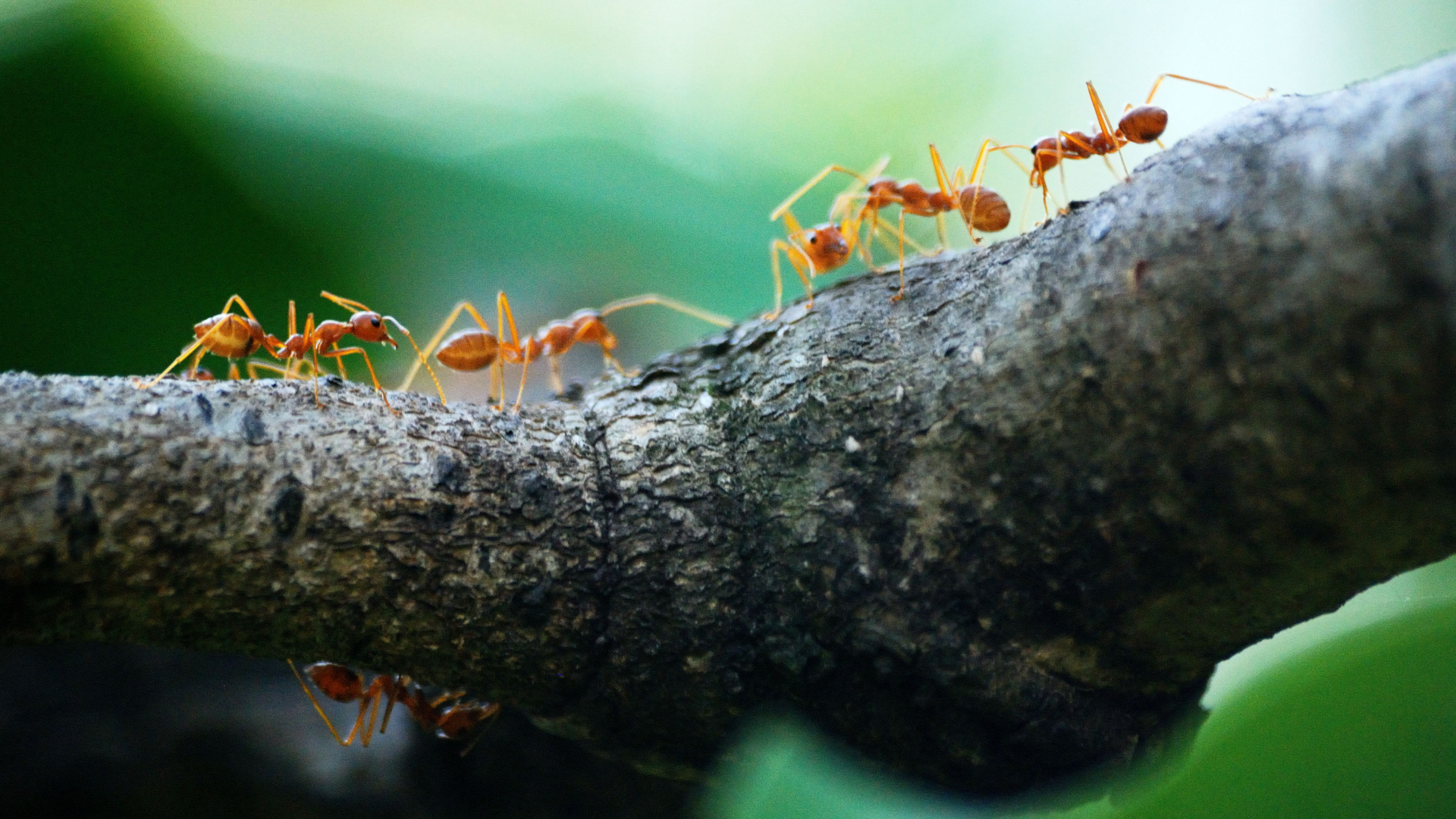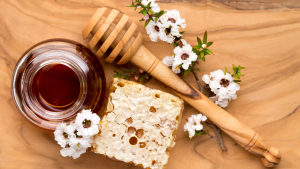“Consider this: all the ants on the planet, taken together, have a biomass greater than that of humans. Ants have been incredibly industrious for millions of years. Yet their productiveness nourishes plants, animals, and soil. Human industry has been here in full swing for little over a century, yet it has brought about a decline in almost every ecosystem on the planet. Nature doesn’t have a design problem. People do.” – William McDonough and Michael Braungart, Cradle to Cradle
Ants are one of the most important species of animals on planet Earth. Along with termites, ants are responsible for the vast majority of soil aeration and turning of earth – moving more soil than all of the world’s farmers combined!
Ants are also major pollinators of a variety of plants and they are the single most important carnivores on the planet – keeping many insects populations from ever reaching drastic pest-level populations. Ants are great at destroying weeds and suppressing their populations, cleaning up to 95% of all weed seeds in fields.
They are highly social creatures, forming vast colonies with multiple roles/castes all working under a queen. A single colony can house up to 20 million ants and some colonies will establish multiple nesting sites and even more satellite colonies if left unchecked.
Ants are highly beneficial insects, however, there are a very select few that can be considered pests, and that is only when they spoil our food or damage our wooden structures. It is common for a home to be invaded by multiple different types of ants, with behaviors that can vary greatly.
This article will help you identify which ants you are dealing with, what food is attracting them, and some quick controls for each. The following is a list of 4 of the most common ants that invade your home.
Table of Contents:
Acrobat Ant (sugar ant)
Carpenter Ant
Fire Ant
Thief Ant (grease ant)
Final Thoughts
Acrobat Ant (sugar ant)
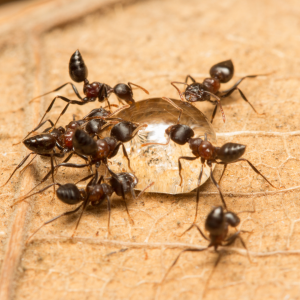
Acrobat ants (Crematogaster spp.) earn their name from the unique way they point their heads or abdomens in the air when excited. These ants fall into the “sugar ants” category, as they are primarily attracted to sweets. Acrobat ants also feed on proteins and enjoy high carbohydrate foods. In nature, acrobat ants will farm & herd honeydew producing insects, like aphids. They harvest the sugars secreted by aphids and will defend them from predators.
Acrobat ants prefer damp or moist areas to nest in, seeking out wet wood, like: rotting logs, trees, stumps, or even abandoned termite or carpenter ant galleries. When invading homes, they tend to make their nests in wet roof boards, foam insulation, firewood, siding, wall voids, and porch rafters to name a few.
Like other ants, acrobat ants will collect their “garbage” and take it out of their nests, often piling it nearby their nest entrances. This can be a tell-tale sign of an acrobat ant infestation.
Acrobat ants will travel up to 100 ft. (30 m) to forage for food. They commonly invade kitchens due to the many sources of water found there. Sink drippings, window sills, and appliances provide ample water that attracts these ants.
Some quick controls: spray acrobat ants as they are seen with TweetMint® Enzyme Cleaner or Not Nice To Bugs®, using a light dilution. *BONUS, when you wipe the ants up you are also cleaning your kitchen counter or floor at the same time!*
Installing dehumidifiers will eliminate excess moisture and provide an unsuitable habitat for the ants to nest in.
Finally, a DIY bait can be made for these ants. Use Karo syrup or honey to attract them. Take household borax and mix in 1% borax to whatever amount/weight of the syrup or honey. Place the liquid baits on pieces of foil or index cards where ants are seen. Keep out of reach of children & pets.
Carpenter Ant
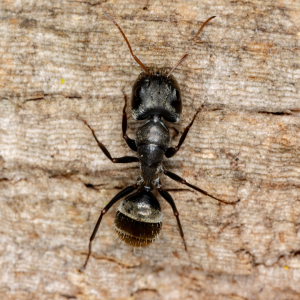
A common misconception about carpenter ants (Camponotus Spp.) is that they eat wood, when in reality carpenter ants only use wood to nest in. This fact actually makes carpenter ants MORE dangerous than termites for potential structural damage. This is because carpenter ants take wood and hollow out large, spacious galleries; severely weakening structural integrity in the process.
*Quick Note* carpenter ants are usually a sign of water leak or moisture problem. They need & want the wood to be wet in order for them to nest.
Carpenter ants are one of the most easily identifiable ants in this article, due to their large size, spanning from 1/4″ to 3/4″ long! If you think carpenter ants may be infesting your home, a quick test is to knock on a wall or hollow door and put your ear close to listen – they will make a crinkling cellophane sound as they move about their nests.
Their diet ranges widely from sugars, proteins, to carbohydrates. Common foods carpenter ants are attracted to in homes are: pet food, candy, grease, meat scraps, fruit, garbage, and peanut butter to name a few. The same borax bait above will work well on carpenter ants.
Some quick controls: spray carpenter ants as they are seen with TweetMint® Enzyme Cleaner or Not Nice To Bugs®, using a light dilution.
Make sure no branches are touching the sides of your home – these are common entry-points. Remove all sources of moisture, fix leaks, and install a dehumidifier(s).
Permanent control is achieved by locating nests & destroying them & the queen. Carpenter ant workers/foragers can be followed back to nests. Flood nests with TweetMint® Enzyme Cleaner or Not Nice To Bugs®.
Fire Ant
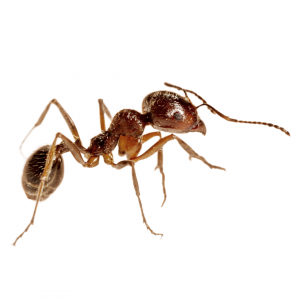
The fire ant (Solenopisis spp.) has gained great infamy due to its highly aggressive behavior & painful sting it can deliver. Dubbed “the six-legged scourge of the South” they have been undergoing a slow march from the Southern United States, to the colder, Northern lands. The venom from their sting can cause blisters, allergic responses, and even anaphylactic shock in severe cases.
Fire ants can be easy to spot due to their bright red exoskeleton, but they are part of a large group of ants that can also be reddish brown or even black. They form large masses & “balls” in severe rain events & floods, and even can travel via wind or on the backs of birds.
Fire ants are omnivores with a large diet, consisting of: crops (corn, strawberries, potatoes), plants/saplings/flowers, grass, mice, turtles & snakes, but usually prefer insects. Their tendencies toward attacking & feasting upon larger vertebrates, coupled with their aggression, mean they will force out all other forms of wildlife in yards & fields; leaving yards barren of mammals, reptiles, & plant life.
Frequently fire ants will enter & nest in homes, seeking out water & electrical currents/magnetic fields. By nesting near electrical wires, they can damage a variety of appliances, transformers, air conditioners, and electrical equipment.
Some quick controls: spray fire ants as they are seen with TweetMint® Enzyme Cleaner or Not Nice To Bugs®, using a light dilution. In the home, it is important to follow workers/foragers back to their nests, usually in wall voids. Food-grade diatomaceous earth (DE) can be dusted behind walls or TweetMint® Enzyme Cleaner or Not Nice To Bugs® can be sprayed.
Outside, flood fire ant mounds with TweetMint® Enzyme Cleaner or Not Nice To Bugs® using 1 oz (30 ml) per quart of water.
A quick, free, non-toxic control is to simply run over fire ants mounds repeatedly with a car or truck; repeat as often as needed. There is simply no place for the use of toxic registered pesticide poisons. Pesticides will actually help the ants and will cause them to form satellite colonies, speeding along their progression of expanding their empire.
If using baits: queens are the first ants to be fed proteins, make sure to use a protein-based bait. Use the above 1% borax concentration and try it out in a few different meat scrap options.
Thief Ant (grease ant)
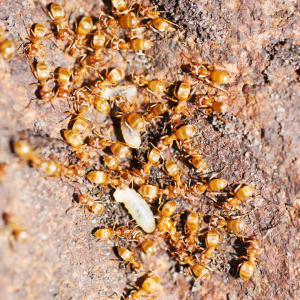
Thief ants (Solenopsis molesta (Say)) gain their name from their tendency to raid and steal the food from rival ant colonies. They are easily confused with Pharaoh ants, as they are both very small & yellow ants. Thief ants are more of a grease loving ant and are included on this list to be characterized with acrobat ants, which are more sugar loving.
Although categorized as a grease ant, thief ants feed on a variety of foods: honeydew from aphids/mealybugs/scale insects, seeds, sweets, and live & dead insects. Their small size means they are able to squeeze through the tightest of cracks, sneaking into packaged foods quite easily. It is important to store all food in tightly sealed containers.
Outdoors, thief ants will nest under debris, rocks, or logs. Indoors, they will nest behind walls, behind baseboards, and cupboards. Locating their nests is difficult due to their small size, and baiting is usually ineffective due to thief ants not eating enough or bringing sufficient amounts of food back to their nests.
Some quick controls: spray thief ants as they are seen with TweetMint® Enzyme Cleaner or Not Nice To Bugs®, using a light dilution. Clean often with TweetMint® Enzyme Cleaner to help eliminate food sources and repel these. ants.
Make sure to caulk & seal all cracks inside and around the home to properly prevent thief ants from entering.
If you would like to try baiting, use the 1% borax method and combine it into bacon grease and honey.
Patience will be your greatest tool in eliminating these ants.
Final Thoughts
Ants are some of the most common pests homeowners deal with, and can be very frustrating. It is important to seek out common-sense, non-toxic methods instead of relying on harmful chemicals for their control.
Pesticide companies know their chemicals do not get rid of ant infestations – in fact, they’re counting on it. They want homeowners to focus on spraying visible ants and apply toxic, contaminating barriers in & around the home. Ants are often the symptom of an ongoing problem, like water leakage. If you correct these problems, often times the ant issue will be corrected as well.
In any event, the only way to fully get rid of any ant infestation is to eliminate the queen/nest. By focusing on the piece of the puzzle, you can avoid using toxic pesticides and safely manage ants in the future!
If you would like to learn more about ants or different species of ants, click here to read more at The Best Control II.
For more sustainable solutions, check out www.safesolutions.com
Want to keep learning more about pests, health, and nature? Keep up with our Bug Blog as new posts are uploaded, or take a look at some older posts!
-Gage

